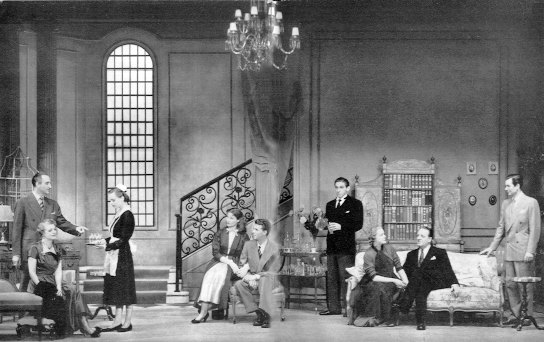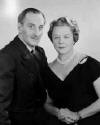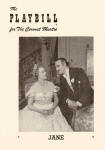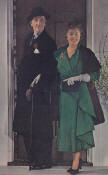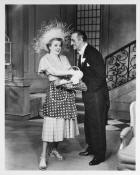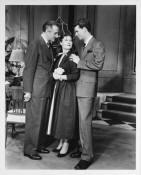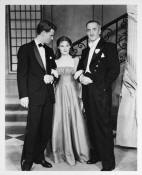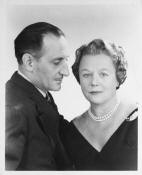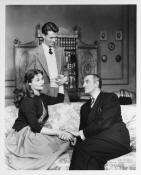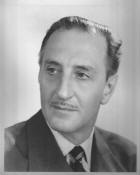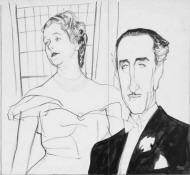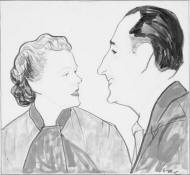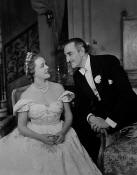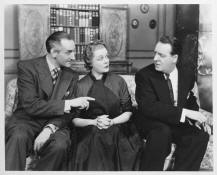Jane
A comedy in three acts by S.N. Behrman, suggested by an original story by Somerset Maugham. Opened at the Coronet Theatre, New York City, February 1, 1952, and ran for 100 performances. Produced by the Theatre Guild, Inc., under the supervision of Theresa Helburn and Lawrence Langner. Directed by Cyril Ritchard and Associate Director Armina Marshall. Setting and costumes designed by Elfi von Kantzow.
Look for pics here: https://collections.mcny.org/CS.aspx?VP3=SearchResult&VBID=24UP1GMV5UQ7O
| Pics to work on: Upstairs: jane25 Here: jane30, |
Ready to compress:
|
Cast of characters
| Ann Tower | Adrienne Corri |
| Peter Crewe | William Whitman |
| Wilson | Al Collins |
| William Tower | Basil Rathbone |
| Millicent Tower | Irene Browne |
| Jane Fowler | Edna Best |
| Maid | Sarah Marshall |
| Lord Frobisher | Howard St. John |
| Gilbert Dabney | Philip Friend |
Based on a short story by W. Somerset Maugham. The comedy "Jane" was first
written in 1947, but not performed on Broadway until 1952. Rathbone's character,
William Tower, is a writer, and is based on W. Somerset Maugham. In fact, the
stage directions state: "The actor who plays William Tower would do well to
study the portraits and read the works of W. Somerset Maugham. . . . Tower wears
a monocle on a broad black ribbon with which he habitually fixes people." [from The Best Plays of 1951-52,
ed. by Burns Mantle (Dodd, Mead and Co., 1952), page 210]
In Act I we learn that William Tower's daughter Ann and her boyfriend Peter, a
poet, are in love. Their relationship faces two challenges, however: 1) Ann's
mother can't stand Peter, and she hopes that her ex-husband Willie can do
something to break up Ann and Peter; and 2) Peter has married a girl in order
for her to obtain a passport. She was being persecuted because of her father's
political opinions, and is now in a concentration
camp.
Mrs. Tower is horrified to learn that her middle-aged sister-in-law Jane Fowler will arrive shortly. Jane, the widow of Mrs. Tower's brother, appears old and frumpy, an actual "plain Jane." Mrs. Tower declares, "She looks twenty years older than I do and she's perfectly capable of telling anyone she meets that we were at school together. When she comes to London it never occurs to her to stay anywhere but here-she thinks it would hurt my feelings."
Also visiting are Willie Tower, who has just returned from a trip to Africa, and Lord Frobisher, a friend and chain-paper publisher. Jane gets along well with Willie. She surprises everyone by announcing that she is going to get married. Her intended (Gilbert Dabney) is about 30 years old, so everyone assumes that he is marrying Jane for her money.
Act II takes place six months later. Peter has had a book of poems published, so he is enjoying some success as a writer. Jane, who had been dowdy and dull, is now the reigning social success of London. She describes her young husband Gilbert as "old-fashioned."
Jane appeals to Lord Frobisher to use his influence to get Peter's wife out of the prison camp. Jane offers to pay the costs, if only Frobisher can make the arrangements. Then Peter and his wife can get a divorce, and Peter will be free to marry Ann Tower.
When Gilbert hears about Jane's meddling in Peter's business, he is angry with her. He decides to take Mrs. Tower to the opera instead of Jane. Willie Tower invites Jane and Frobisher to dinner.
When the curtain rises for Act III, it is ten days later. Tower speaks to Jane, expressing concern for Ann and Peter. Jane says she plans to adopt Peter's wife, who is out of prison and on her way to England. Gilbert responds to this news by saying, "This time Jane has gone too far." After confronting Jane, Gilbert leaves her.
Frobisher comes in just as Gilbert is leaving, and Tower explains what happened. "Serves her right," remarks Frobisher. Tower observes that Frobisher is so rude to Jane that he must be very taken with her. Tower appalls Frobisher by suggesting that he might enjoy being married to Jane. "Last man on earth for anyone to marry," says Frobisher. Tower states that he'd be a better husband than Frobisher, and the two men continue to banter about who should marry Jane.
The play ends with Jane admitting that she loves Frobisher, and he proposes.
*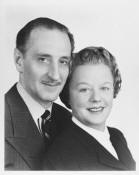 Edna Best and Basil Rathbone (photo by Vandamm) 421 X 536 replace with 20 |
 TINY |
*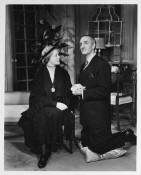 Rathbone and Edna Best (photo by Vandamm) LARGE |
When Jane opened on Broadway in February 1952, one critic then wrote: ''High comedy has almost vanished from the American theater, which for the past few seasons has been so busy with problems and depressing people that it has almost forgotten how to induce laughter.'' —from the New York Times, 1987
The character of William Tower, was fashioned after W. Somerset Maugham, the author of the short story from which the play was adapted. Tower's ex-wife, Millicent, was patterned after Maugham's wife, Syrie. The character of Allan Frobisher also had a real-life counterpart: Canadian newspaper tycoon Lord Beaverbrook.
Review in Time magazine, February 11, 1952:
|
Jane (adapted by S. N. Behrman from a Somerset Maugham short story) is an urbane but upsy-downsy drawing-room comedy. Its three acts of intended laughter rather suggest three sets of tennis, with Jane narrowly losing the match, 6-2, 1-6, 4-6. Jane (Edna Best) is a rich, frumpish, middle-aged Liverpool widow, hard of head and blunt of speech. In a jolly first act she descends on her London relatives to announce that she is marrying a penniless architect half her age. There is consternation, opposition, and the sense of a cheerful future for the play, if perhaps a checkered one for the heroine. In Act II, Jane's talent for dropping hot bricks has apparently made her the rage of London, though nothing is actually shown but her incurring the rage of Londoners. There is no verve in it: things merely dribble along, with Jane tiring of society and the young husband tiring of Jane. In the last act, by flanking Jane with a worldly writer who might be Maugham (Basil Rathbone) and a philandering newspaper tycoon (Howard St. John), the play manages a few rallies, but never quite comes right. Only the air of the drawing room persists to the end; despite Edna Best's smooth playing, the charm of Jane fades out. Halfway along, she stops seeming faintly absurd and at once stops seeming alive. And she doesn't cut a wide enough swath, cause enough contretemps, shake up enough lives. In the end, the strong point of the play seems almost as much comment as character. Read more: http://www.time.com/time/magazine/article/0,9171,815980,00.html#ixzz1XhP8fD00 |
Dramatist S. N. Behrman, one of the Theatre Guild's foremost writers, was frequently referred to as an American Noel Coward. In addition to Jane, he wrote Biography, No Time for Comedy and The Second Man.
Review of "Jane" in Billboard, February 9, 1952:
| Behrman's "Jane" Sparkles Wit, But Somewhere
a Play is Missing by Bob Francis No playwright around these days can handle a comedy of manners better than S.N. Behrman, and it is a treat again to listen to a polished, witty dialog. He has put a lot of it into his comedy Jane." Conversationally, it sparkles a great deal of the time. But unfortunately its premise is frail and rather silly, and gets nowhere beyond engendering a certain genial warmth—certainly not enough to put the heat on the Coronet's box office for any protracted period. Behrman's plot is based on a story of Somerset Maugham's about a middle-aged ugly duckling who belatedly takes on swan plumage. In this case, she is an elderly provincial widow who descends on a Mayfair menage and turns it end-over-end via sheer charm. She marries a lad half her age, lets him desert her, and angles herself into a third set of wedding bells with a tycoon as well known for his bedroom antics as for his ability as a publisher. Along the way, she serenely arranges the marital happiness of a niece, utterly confounds a meanish sister-in-law, and almost snares a cynical brother-in-law. All of which is accomplished in the most naively ingenious manner, even if it is quaintly unbelievable. It is, however, played for the most part on a wonderfully brittle, high-comedy plane by its principals. Edna Best creates a delightful portrait of the guilefully guileless lady who charms by merely telling the truth. She is particularly adept at this type of comedy. Adept, also, is her co-star, Basil Rathbone. As a sort of bystander to the story, in which he gets involved in spite of himself, Rathbone plays one of Maugham's typical suave, cynical writing men. You do not often meet a man with such a singularly continuous flow of wit,
but Behrman has given him amusing
things to say, and he gets all the best out of them. But it is Howard St. John's
teaming with Miss Best which gives the play its best moments. The former's
growing frustration as a self-confessed roue, as he falls under the lady's
spell, are real high spots in an otherwise conversational evening. Having knowing players to work with, plus a high-comedy perception of his
own, Cyril Ritchard has staged these drawing-room doings effectively, although
there are considerable stretches of chit-chat that get his inventiveness down. |
The New York Times article from
February 10, 1952 (S. N. BEHRMAN'S 'JANE';
Edna Best and Basil Rathbone Playing in a Theatre Guild Production,
by Brooks Atkinson) is available to
purchase. Click here for more information:
http://select.nytimes.com/gst/abstract.html?res=F10A17FD355C177B93C2A81789D85F468585F9
The following is an article from The New York Times, March 30, 1952:
| QUERY: WHAT MAKES COMEDY HIGH? By S. N. BEHRMAN Dramatist, Scenarist, Biographer I know that the press agent for my new play at the Coronet Theatre will be unhappy if I don't mention "Jane," and it is a primary function of the playwright to keep the press agent in amiable spirits. Maugham's short story, on which the play is based, tells about an elderly frump from Liverpool who marries a very young and very attractive man. Miss Theresa Helburn of the Theatre Guild wished me to adapt it. Mr. Maugham, who is one of the canniest of men, has sold the film rights to everything he has ever written—he has recently even been selling the rights to his fascinating personality; but he never sold the film rights to "Jane," although it is over thirty years old; because he felt that it would one day make a play. Difficult Task Also, and this is the nub, instead of the young man's eventually leaving Jane, as everyone predicts, Jane leaves the young man. This was a puzzler. Why? I gave this as much thought as Newton and Satan gave the apple—with somewhat less epochal results. One line gave the play to me and the answer. When Gilbert asks Jane why she is leaving him, she says: "Because you are too old for me!" This line was, originally, the curtain of Act Two, the climax of the play. In the prolonged neurasthenic hypochondria which constitutes a try-out tour, I allowed this line to be shifted to Act Three. The point I wanted to make in the play is that youth is a question of vitality, generosity, warmth and general sympathy in point of view. A stuffed shirt may be old at 20. Jane is alive and vital and will be young at 80. |
source: http://snbehrman.com/library/nytimes/52.3.30.htm
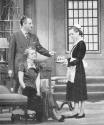 Rathbone with Irene Browne and Sarah Marshall TINY rescan? |
|
*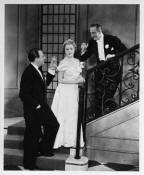 Howard St. John, Edna Best and Basil Rathbone (photo by Vandamm) LARGE |
This review is from Billboard, January 26, 1952:
| It would be stretching imagination a bit to rate "Jane"—the delightful old gal
that she pans out to be—as headed for the hit class. However, the artful S.N.
Behrman may well be able to tie some new knots, point up the punches and weave
together its scattered virtues so that his high comedy doesn't remain as utterly
shallow as the British high society that it mocks. For this venture, Behrman has turned to another high-handed writer of high comedy, by using as his theme W. Somerset Maugham's original story of the same name as his theme. Completely delightful and entirely amusing, Behrman has made his lady of the title warm and human even if she isn't real. But there isn't enough overall substance to last a full-length theater evening, nor does the comedy build into any lasting crescendo to make for any sort of sustained sock to take "Jane" out of its present element of lightness that leaves a pew sitter with a singularly empty feeling. Story-wise, there isn't much to tell. But Behrman takes a lot of words—too many—to tell the tale of "Jane," the dowdy provincial woman who comes to London to visit her sister-in-law. Capturing the fancy of a man young enough to be her son rather than her husband, the country widow subsequently undergoes a complete transformation physically. But while she loses her Queen Victoria luster, she never loses her capacity for telling the truth—even to the loss of a husband—and in turn wins the heart of a newspaper publisher who loses his confidence as a rake and philanderer once he falls under her spell. It is Edna Best, as Jane, and Howard St. John, as the hard-drinking and romantically inclined publisher, who provide the play with its highest moments both in character and in comedy. Both score decisively. Basil Rathbone, who plays the "I" of the original short story, a writer named William Tower, is supposed to have surface resemblances to Maugham, but seems ill at ease with the part. Nor is he able to capture the comedy spirit of the play. Primarily he is Basil Rathbone playing at being the carefree, colorful writer-world-traveler who comes back to visit a divorced wife, only to fall in love with his sister-in-law, Jane. And his biggest miss is when he comes in second best in the race for the latter's hand. . . . As a whole, the casting and acting is excellent, with Cyril Ritchard establishing a tempo that moves plausibly even if the verbiage tends to slow it down in too many spots. . . . It must be said that "Jane" tries hard and with good intentions. But good intentions are not enough to jam a box office window. |
* * * * * * * * * *
the New Yorker
JANE
S.N. Behrman based "Jane," the new comedy at the Coronet, on a short story of the same name by W. Somerset Maugham. He based the tone of the play's language, I would guess, on a conviction of his own, which he has put to work many times before now, to the satisfaction of a great many audiences, that every line of dialogue in a play about rich and educated people should be coated with at least half and inch of polish. As a result, while some of the lines in "Jane" are funny and some are not, they all have the same sort of surface quality; all of them are delivered--by the members of an efficient cast, who are not paid to scratch beneath this surface--as though they were bon mots; and the audience laughs reflexively, though cordially, at each invitation. This audience reaction (I am judging by the audience at the first night; I doubt if those that follow will be any tougher) is a tribute to the infectious power of Mr. Behrman's belief in the universal wittiness of the upper classes.
Just the same, if you put a strong lens on "Jane," I think you will find that the silken flow of the writing is pieced out here and there with ribbons of dental floss. "My heart goes out to you," says one lady to another, in I think, the third act. "Does it! Why?" asks the second lady. "I don't know why, but it does," says the first lady, with hardly a moment's hesitation. At another point, someone speaks of the need of getting a certain cad out of a certain garden, which inspires someone else to remark that if you were to try to eliminate all cads from gardens, you would have your hands full. If you were to eliminate all exchanges like that from plays like "Jane," you would have your hands full making plays like "Jane" last two hours.
However, anyone who shares Mr. Behrman's enthusiasm for dialogue per se will probably enjoy himself at the Coronet. There are two fine performances, by Edna Best and Howard St. John, and two others, by Basil Rathbone and Irene Browne, that are faintly ridiculous, but amusing. There is a plot, which came to Mr. Behrman, by way of Mr. Maugham, from "Cinderella" and "Come Out of the Kitchen." Miss Best evolves from a dowdy Liverpool housewife into the glowing belle of London society. The change, as supervised by the director, Cyril Ritchard, is perhaps unnecessarily spectacular. In the first act, Miss Best wears what looked to me like a suit of frontiersman's buckskins borrowed from a Buffalo Bill show. It's surprising that they didn't ask her to paint a mustache on her lip, to hammer the point home.
John Lardner, The New Yorker, February 9, 1952, p. 56-57
"While some of the lines in "Jane" are funny and some are not, they all have the same sort of surface quality; all of them are delivered—by the members of an efficient cast, who are not paid to scratch beneath this surface—as though they were bon mots; and the audience laughs reflexively, though cordially, at each invitation. ... There are two fine performances, by Edna Best and Howard St. John, and two others, by Basil Rathbone and Irene Browne, that are faintly ridiculous, but amusing." —John Lardner, The New Yorker, February 9, 1952
* * * * * * * * * * * * * * * * * * * * * * * * * * * * *
citation for ETJreviewJane1952:
As for Jane, I believe it is a wise or, at least, very clever comedy, weak during the first half of the second act but decidedly a relief from humdrum writing. Whether it could have any effect with a cast that has no actors comparable to Edna Best, Basil Rathbone, Howard St. John, and Irene Browne is another matter. For the present analysis of the Broadway season, I find it necessary only to point to the brilliant cartwheels performed by Behrman in making a middle-aged wife discover that her young husband is "too old" for her and in making a comedy of manners connotative rather than merely denotative when it examines characters and attitudes. Behrman has a mind nimble enough to do some broken-field running that most of his colleagues on Broadway are too heavy footed to even attempt. Still, it would be extravagant to claim that a Jane can be—or, for that matter, should be—more than an interlude in our continuing efforts to create an American drama and theatre. Behrman's kind of artistry, no matter how genial, thrives on detachment, whereas American playwriting has been more or less memorable only when it attaches itself without reservations and, as a rule, less than genially to a common life made uncommonly absorbing. The hazards of dependency upon such attachment are many and obvious; the main pitfall is a precipitate drop into commonplaceness, and yet the risk has been taken and must be taken again if our dramatists are to prevail sufficiently.
"Jane ... is a wise or, at least, very clever comedy, weak during the first half of the second act but decidedly a relief from humdrum writing. Whether it could have any effect with a cast that has no actors comparable to Edna Best, Basil Rathbone, Howard St. John, and Irene Browne is another matter." —John Gassner, "Broadway in Review," Educational Theatre Journal, May 1952
* * * * * * * * * * * * * * * * * * * * * * * * * * * * *
Variety, January 16, 1952
Plays Out of Town
Jane
Wilmington, Jan. 10
Theatre Guild presentation of comedy in three acts by S.N.Behrman, based on an original story by w. Somerset Maugham. Stars Edna best, Basil Rathbone, features Howard st. John, Irene Browne, Philip Friend. Directed by Cyril Ritchard. Set by Elfi Von Kantzow. Production under supervision of Theresa Helburn and Lawrence Langner. At Playhouse, Wilmington, Jan. 10, '52.
"Jane" has many hit potentialities, such as sparkling lines, clever situations and an excellent cast, but as presented here the final impression isn't too satisfying. Drastic changes will be needed before it reaches Broadway if it is to make the grade.
These should not be too difficult, however. The play, written by s. N. Behrman from an original story by W. Somerset Maugham, now runs almost a half-hour overtime. When the necessary cuts are made and the action speeded in the early part of the first act, it should prove a real contender.
The plot deals with "a bawdy old frump from Liverpool," Jane Fowler, who in 1938 decides to marry a young, handsome architect, Gilbert Dabney. She goes to London before the marriage to win the approval of her sister-in-law, Mrs. Millicent Tower, a society leader. Millicent's divorced husband, William Tower, a globetrotting writer with a "great ability for general disparagement," is on one of his rare visits to his daughter, Ann. Millicent is hoping for a proposal from Lord Allan Frobisher, owner of a string of newspapers who likes his liquor and has a knack with women.
In the second act, six months later, Dabney has completely "reupholstered" Jane, who has now become one of the best-dressed and most popular women in London. She has decided, however, that she had best leave Dabney, who has remained faithful, and marry some one of her own age. She wins a proposal from the cynical Tower with ease, but has much more difficulty with Frobisher, whom she really loves.
A secondary plot deals with the love of Ann Tower for Peter Crewe, a young poet who loves her but cannot marry, because he already has a wife in a German concentration camp. That marriage he explains, was a mere passport affair to get the young actress out of Germany, but it had not succeeded as she had been arrested before she could leave. Ann's mother disapproves of Crewe, and her father is at first cynically indifferent toward him. They win the sympathy of Jane, however, who gets Lord Frobisher against his better judgment to pull the necessary stings to have Crewe's wife released and sent to London, where Crewe can obtain a divorce.
Edna Best is brilliant in the title role, making thoroughly plausible the great change in the character that occurs between the first and second act. Basil Rathbone gives a suave, polished reading of the role of William Tower, the cynical author. Howard St. John is excellent as Lord Frobisher. One of the high points of the play is his drunken scene, which he skillfully underplays. Irene Browne wrings all the laughs possible from her role of Mrs. Tower. Adrienne Corri is a fresh, beautiful Ann. Both Philip Friend, as Gilbert Dabney, and William Whitman, as Peter Crewe, are highly competent.
Klep.
"Edna Best is brilliant in the title role, making thoroughly plausible the great change in the character that occurs between the first and second act. Basil Rathbone gives a suave, polished reading of the role of William Tower, the cynical author." —Variety, January 16, 1952
* * * * * * * * * * * * * * * * * * * * * * * * * * * * *
Variety, February 6, 1952
Plays on Broadway
Jane
"Jane" is a mass of contradictions. It has a droll premise, an awful lot of talk and considerable wit, but isn't much of a play. It's expertly played and deftly staged, but it frequently seems pretty hollow. Its characters appear to be rather shallow, but they're mostly inclined to be likeable at heart. The show itself should have a moderately good run, but isn't likely to have mass popularity.
In style and treatment, "Jane" is characteristic of its authorship. It was dramatized by S. N. Behrman ("suggested by," the program expresses it) from a story of W. Somerset Maugham, and is a suave, wise, amusing but strangely synthetic yarn that never quite seems to achieve concrete form or reality. Bu artful handling makes it palatable, if not superlative entertainment.
The story, somehow not entirely credible, is about a dowdy, middle-aged Liverpool widow who marries a penniless young architect, blossoms out in glad rags and becomes the rage of London smart set on the novelty of her directness instead of the usual small talk. After that diverting start, however, "Jane" becomes somewhat murky in plot and characterization, and is less satisfying theatre.
As title actress and top star, Edna Best gives a superb comedy performance that is primarily responsible for saving the show. Her bland, deceptively mild style of comedy playing is hilarious and, teamed with the crisp manner of Basil Rathbone, her co-star, or the emphatic impact of Howard St. John, is irresistible. Rathbone gives definition to the role of a sardonic foreign correspondent-novelist-playwright (said to be at least a semi-portrait of Maugham), while St. John is funny if not too convincingly self-satisfied or arrogant as a self-indulgent newspaper magnate.
Irene Browne presents a shrewdly comic portrait of a fashionable feline divorcee and Philip Friend gives a genuinely skillful performance in the difficult part of Jane's "young man." Among the non-featured parts, Adrienne Corri is believable as a rather stereotype heroine, William Whitman is plausible as her impractical fiance, and Al Collins and Sarah Marshall (the latter the daughter of Miss Best and ex-husband Herbert Marshall) are acceptable in bit assignments.
Cyril Ritchard's staging is perceptive and has an infectious flavor. The Elfi von Kantzow drawing room setting has the traditional brightness for comedy, but doesn't look like the sort of interior any normal playgoer is ever apt to see outside a theatre. Valentina's gowns for Miss Best are scrumptious.
Hobe.
* * * * * * * * * * * * * * * * * * * * * * * * * * * * *
New York Times, February 10, 1952
S. N. BEHRMAN'S 'JANE'
Edna Best and Basil Rathbone Playing in a Theatre Guild Production
by Brooks Atkinson, The New York Times, February 10, 1952
Taking some characters and a hint or two out of a Somerset Maugham story, S. N. Behrman has written a lively comedy of manners, "Jane," with which the Theatre Guild has brightened a lugubrious season. "Jane" is the sort of literate artifice the theatre has always had a genius for. It can be acted. In the present instance it is acted brilliantly by a cast led by Edna Best and Basil Rathbone, who would doubtless be willing to pay a little something for the privilege of speaking such tidy lines. For the comedy of manners is all theatre and the chief of the theatre's extravagances. It squanders some of the theatre's rarest skills on the trick of saying nothing. Ever since "The Second Man" slipped into the Theatre Guild's hope chest in 1927, Mr. Behrman has been the chief writer of comedies of manners in America. Without being self-conscious about it, he is a stylist. He has taste, standards and skill. As a matter of fact, he has something more than that. He has conscience. He has always been haunted by the fear that composing light comedies is not a respectable profession in an ominous, violent, blood-stained world. In "No Time for Comedy," in which Katharine Cornell acted in 1939, he stated his problem modestly and engagingly; and "Rain From Heaven" and "End of Summer" were animated by similar personal misgivings.
Drawing Room Romp
In "Jane," however, he has no more conscience than you can find in Somerset Maugham, who has spent a lifetime posing as though he had none. For this is an idle romp in an English drawing room in 1938, when the world was just getting ready to explode. Standards of responsible behavior are hinted at occasionally. Jane, who is a provincial lady of considerable integrity, reminds the fops, cads and sybarites that perilous things are happening in the world and that selfishness is one of the mean vices. But these random glimpses into probity are only fleeting signposts that provide dramatic contrast. For the substance of "Jane" is the intrigue, malice, boredom and worldliness that have captivated writers of light comedies since the frivolous youth of Shakespeare and the ornate days of the Restoration. Mr. Behrman can turn a phrase with the best of them. He can make the English language dance and gleam.
Since he has more scruples than Noel Coward, for example, he frequently has trouble in designing a story flexible enough to carry the dialogue easily. His lightness of style is anxiously achieved. Although "Jane" is a vast improvement over the jejune sentimentalities of "I Know My Love," it is not exactly ideal. No one can define the theme. Is Mr. Behrman proving that a middle-aged woman should not marry a youth in his twenties, or that the example of wholesome woman can reform a rake, or that young people should marry for love and not for advancement? All these ideas turn up amid the follies of "Jane" and pull the story off at tangents. there are some labored spots, particularly in the second act, when solemn ideas intrude on the dialogue.
Character Creation
If Mr. Behrman were not such a gifted stylist the irresolution of the story might destroy the gaiety of his comedy. But out of the glitter of satiric dialogue he can create characters vividly. Fantastic as the people may seem to be on the surface, they derive from reality. Jane is a forceful, candid, incorruptible woman who emerges above the heartlessness of the dialogue with something approaching grandeur. There is a cynically successful newspaper magnate whose odious braggadocio Jane manages to deflate swiftly with a few sardonic remarks. These two characters are in oppoostion and they are not static, as they would be in a farce. While the one grows in size the other diminishes, and they keep Mr. Behrman's comedy in motion. Althought the point of view is whomsical, the dramtic growth of character is genuine.
Worldly Writer
But the character Mr. Behrman is fondest of is a fiction and comedy writer called "Willie" who stands just outside the action, observing it with mischievous relish. Rich, elegant, sagacious, impeccable in his choice of words, he represents W. Somerset Maugham, master of the genre. When "Jane" was produced in London Mr. Maugham may have been astonished to find himself moving through the ballet pattern of one of his own stories, cautiously dissociating himself form the social dilemmas it chronicles. Since Mr. Behrman's talents as prose writer are equivalent to Mr. Maugham's, there is no sycophancy in the portrait. On the contrary, there is some shrewd criticism and some genial satire of Mr. Maugham's disdainful point of view. But it is a portrait written with respect and understanding as well as humor and it emerges as the most winning character in the play.
Mr. Rathbone is ideal in the part. He is crisp, immaculate and good humored, and he speaks some elaborately written lines with wry punctilio. As Jane, Miss Best radiates a sort of indomitable good nature that conquers the play. She has designed the part with comfortable relish of the wayward humors that saunter through it. Howard St. John plays the newspaper bounder with droll enjoyment of the bombast, the vulgarity and the penitence. Irene Browne expertly acts the part of a nervous egotist who represents the brittle manners of the smart world. As an unctuous opportunist, Philip Friend gives an agreeable cunning performance.
Performance Tradition
If the performance as a whole is extraordinarily subtle, silken and pertinent, it must be because Cyril Ritchard, the director, knows so much about comedy of manners. He played in John Gielguds production of Congreve's "Love for Love." Tow seasons ago he played the supercilious coxcomb in Vanbrugh's "The Relapse." Those plays are part of the same theatrical tradition--mannered, artificial, epigrammatic. That's where "Jane" belongs. For Mr. Behrman is a brisk man with the jester's language.
"This is an idle romp in an English drawing room in 1938, when the world was just getting ready to explode. Standards of responsible behavior are hinted at occasionally. ... The character Mr. Behrman is fondest of is a fiction and comedy writer called 'Willie' who stands just outside the action, observing it with mischievous relish. Rich, elegant, sagacious, impeccable in his choice of words, he represents W. Somerset Maugham, master of the genre. When Jane was produced in London Mr. Maugham may have been astonished to find himself moving through the ballet pattern of one of his own stories, cautiously dissociating himself form the social dilemmas it chronicles. Since Mr. Behrman's talents as prose writer are equivalent to Mr. Maugham's, there is no sycophancy in the portrait. On the contrary, there is some shrewd criticism and some genial satire of Mr. Maugham's disdainful point of view. But it is a portrait written with respect and understanding as well as humor and it emerges as the most winning character in the play. Mr. Rathbone is ideal in the part. He is crisp, immaculate and good humored, and he speaks some elaborately written lines with wry punctilio." —Brooks Atkinson, The New York Times, February 10, 1952
* * * * * * * * * * * * * * * * * * * * * * * * * * * * *
Catholic World, 174:465, March 1952
JANE. She's been rumored just round the corner for some years and now at last S. N. Behrman has decided to introduce to the stage the heroine he met in a Somerset Maugham story.
There is no denying that Miss Edna Best makes Jane, who is Millicent's dowdy sister-in-law from Liverpool, a very pleasing character. But why must dowdy characters always be smarted up for Act II? Effective as is the Valentine evening gown, Jane had more personality in Act I. The comedy loses its momentum after Jane changes her clothes but Mr. Behrman always has enough smart dialogue for three acts, and a cast of experts in smart comedy make the most of every twist and sally with Basil Rathbone, as a replica of Mr. Maugham, alerted to inject the expected but of cynicism.
The basic idea of Jane is that any woman simple enough to tell the truth may hope to be the toast of the London season but the truth is that Jane herself is gently very shrewd. The young love story is rather carelessly integrated into the action and the characters have a naive way of asking each other to leave the room when the playwright comes to the next scene. They also change partners with such celerity that the proposals antedate any preparations for divorce. It is true that Millicent's famous ex-husband raised an eyebrow over the new furnishings of her Regents Park drawing room but what has been provided by a new designer, Elfi von Kantzow, must be worse than anything Millicent could have dreamed up!
Adrienne Corri, whose auburn beauty decorates the screen of The River, is the daughter of Millicent (Irene Brown). Miss Best's actual daughter plays the parlormaid. The journalist peer who succumbs to Jane, is Howard St. John. Millicent loses all the way round. As Jane says, she should never have lot go of Willy, who is really Somerset Maugham. Fortunately, Jane takes care that Willy (Basil Rathbone) has a prominent part in her play.
"A cast of experts in smart comedy make the most of every twist and sally with Basil Rathbone, as a replica of Mr. Maugham, alerted to inject the expected but of cynicism." —Catholic World, March 1952
* * * * * * * * * * * * * * * * * * * * * * * * * * * * *
Variety, January 16, 1952
Jane
Wilmington, Jan. 10
At Playhouse, Wilmington, Jan. 10, '52
"Jane" has many hit potentialities, such as sparkling lines, clever situations and an excellent cast, but as presented here the final impression isn't too satisfying. Drastic changes will be needed before it reaches Broadway if it is to make the grade.
These should not be too difficult, however. The play, written by S. N. Behrman from an original story by w. Somerset Maugham, now runs almost an half-hour overtime. When the necessary cuts are made and the action speeded in the early part of the first act, and in portions of the second act, it should prove a real contender.
The plot deals with "a bawdy old frump from Liverpool,' Jane Fowler, who in 1938 decides to marry a young, handsome architect, Gilbert Dabney. She goes to London before the marriage to win the approval of her sister-in-law, Mrs. Millicent Tower, a society leader. Millicent's divorced husband, William Tower, a globetrotting writer with a "great ability for general disparagement," is on one of his rare visits to his daughter, Ann. Millicent is hoping for a proposal from Lord Allan Frobisher, owner of a string of newspapers who like his liquor and has a knack with women.
In the second act, six months later, Dabney has completely "reupholstered" Jane, who has now become one of the best-dressed and most popular women in London. She has decided, however, that she had best leave Dabney, who has remained faithful, and marry some one of her own age. She wins a proposal from the cynical Tower with ease, but has much more difficulty with Frobisher, whom she really loves.
A secondary plot deals with the love of Ann Tower for Peter Crewe, a young poet who loves her but cannot marry, because he already has a wife in a German concentration camp. That marriage, he explains, was a mere passport affair to get the young actress out of Germany, but it had not succeeded as she had been arrested before she could leave. Ann's mother disapproves of Crewe, and her father is at first cynically indifferent toward him. They win the sympathy of Jane, however, who gets Lord Frobisher against his better judgment to pull the necessary strings to have Crewe's wife released and sent to London, where Crewe can obtain a divorce.
Edna Best is brilliant in the title role, making thoroughly plausible the great change in the character that occurs between the first and second act. Basil Rathbone gives a suave, polished reading of the role of William Tower, the cynical author. Howard St. John is excellent as Lord Frobisher. One of the high points of the play is his drunken scene, which he skillfully underplays. Irene Browne wrings all the laughs possible from her role of Mrs. Tower. Adrienne Corri is a fresh, beautiful Ann. Both Philip Friend, as Gilbert Dabney, and William Whitman, as Peter Crewe, are highly competent.
Klep.
* * * * * * * * * * * * * * * * * * * * * * * * * * * * *
Reviews:
Catholic World, 174:465, March 1952
Commonweal, 55:496, Feb. 22, 1952 1952-02-22
Nation 174:162, Feb. 16, 1952 (Jan. - June 1952)
New Republic, 126:23, Feb. 18, 1952
New York Theatre Critics Reviews, 1952:376
* * * * * * * * * * * * * * * * * * * * * * * * * * * * *
A CurtainUp Review
Jane
By Macey Levin
http://www.curtainup.com/jane.html
S.N. Behrman was a major American playwright from the 1920's through the '60's,
creating light fare with references to contemporaneous issues. Many of his works
are drawing room comedies that employ sophisticated wit and sharp insights to
societal and world problems. This is the case with Jane,
produced in America in 1952, written in the mid-'40's, set in 1937 London, based
on a 1920's short story by W. Somerset Maugham and receiving its first
production since '52 by the Peccadillo Theater Company at the Bank Street
Theatre.
The widowed and middle-aged Jane Fowler arrives in London to inform her
sister-in-law Millicent Tower that she is about to wed a much younger man. This
leads to plot situations and conversations centered on inter-generational
marriages and differing perspectives on age and life's challenges. Mix into this
Millicent's daughter Anne's involvement with a young man, Peter Crewe, whose
wife is in a German prison camp in Austria and the situation produces
observations on the evolving turmoil leading to World War Two.
Allan Frobisher, a publisher who owns several Enquirer type
newspapers, prompts Jane's criticism for his tawdry and sordid journalism. The
importance of responsible reporting is yet another thematic statement.
Jane is forthright to a fault. Behrman uses her honesty and directness to create
witty and incisive comments about human relationships and world affairs which
tend to complicate the protagonists' lives. It would seem that these various
plots and subjects would make the play feel make a scatter-shot work, but thanks
to Behrman's facile dialogue and story-telling, they all fall into place in a
logical and dramatically effective structure.
What is necessary for the sophisticated dialogue that turns into verbal farce is
a cast that is adept at its communication. .
The above is not about the 1952 production.
* * * * * * * * * * * * * * * * * * * * * * * * * * * * *
The Best Plays, 1951-1952, and the Yearbook of Drama in America
page 209
The play was first produced in England and in Sweden; in Sweden it had a long run, and the New York stage set¬ ting was a duplicate of the one used in Sweden. In London, “Jane” was, in intent and successful achievement, quite farcical; but, since Londoners seem to like farce better than New Yorkers do, Behrman made a new adaptation for the Broadway trade which was much closer to high comedy.
* * * * * * * * * * * * * * * * * * * * * * * * * * * * *
Among Behrman's additions to the original story are a parody of publisher Lord Beaverbrook, and a character modeled after Willie Maugham himself. The flighty divorced hostess resembles Maugham's ex-wife.
Jane had a pre-Broadway tryout at the Walnut St. Theatre in Philadelphia for two weeks, beginning Monday, January 14, 1952. Matinees Thursday and Saturday.
* * * * * * * * * * * * * * * * * * * * * * * * * * * * *
It was first staged in Britain December 1946 at the Grand Theatre in Blackpool. Its West End run at the Aldwych Theatre lasted for 274 performances from 29 January to 27 September 1947. The original cast included Yvonne Arnaud in the title role, as well as Irene Browne, Ursula Howells, Ronald Squire, Charles Victor. Arnaud was praised for her comic acting.[1]
In 1952 it was staged at the Coronet Theatre on Broadway, lasting for more than a hundred performances.
Irene Browne was in London production
EB and Howard St. John did a preliminary engagement of Jane in July 1951 at the Westport Country Playhouse, Westport, CT. It was then called "The Foreign Language." BR was not part of that engagement.
********************
From NY Times, November 9, 1951:
Rehearsals for Jane to begin mid-December
********************
From NY Times, February 1, 1952:
Premiere of Jane is set for Tonight
By Sam Zolotow
Weaver of silken phrases and contriver of double-edged retorts, S.N. Behrman finally will have the satisfaction of escorting "Jane" into the Coronet this evening. His twelfth play for the Theatre Guild and the group's fifth subscription offering of the season, the comedy will be presented at eight o'clock with Edna Best and BR starred.
Suggested by a story in "East and West," a collection of yarns by Somerset Maugham, "Jane" has traversed a rugged path since it first was earmarked for production in 1946. A year later --Jan. 29, 1947, to be exact --Londoners attended the adaptation with Yvonne Arnaud and Ronald Squire in the parts held by Miss Best and Mr. Rathbone.
When it opened there, Variety's thin-blooded critic pointed out it was warmly received on one of the coldest nights in fifty years.
Subsequently, structural upheavals overtook the script on six different occasions as well as a couple of other titles -- "Period Piece" and "The Foreign Language."
Last summer the play, which tells of the meteoric social rise of a bawdy frump endowed with a passion for truth. was tested on the summer circuit. Retained from that cast are Miss Best and Howard St. John. The only one brought over from the original London aggregation is Irene Browne. She and Mr. Rathbone are said to be prototypes of Mr. Maugham and his wife.
Other members of the company are Philip Friend, absent for fifteen years since "French Without Tears," who had to leave "Faithfully Yours" before it came to New York because of Equity's alien regulations; Adrienne Cori, picture actress in her local stage bow; Sarah Marshall, Miss Best's daughter, who impersonates a maid, and William Whitman.
Cyril Ritchard staged the production, accoutred in costumes and setting of Elfi von Kantzow with gown designed for Miss Best by Valentina.
********************
From NY Times, February 17, 1952:
Performance of "Jane" on April 17 to benefit Foster Home Department of the Children's Aid Society.
********************
From NY Times, April 18, 1952:
"Jane" isn't faring as well as anticipated at the Coronet. Consequently, the Theatre Guild is planning to withdraw S.N. Behrman's drawing-room comedy, suggested by a Somerset Maugham story, on Saturday night of next week. It is hoped, though that the closing may be averted if dilatory theatregoers, who haven't seen the comedy starring Edna Best and BR, make up their minds--quickly, please!--to attend.
Regardless of the decision, there will be no interference with next Monday night's early curtain, scheduled to go up at 7:30.
On the boards here since Feb. 1, the play achieved a run of eleven months in London. Five local critics placed their stamp of approval on the production; three voted against it. This papers official inspector said the following in his critique:
"Matching Mr. Behrman and Mr. Maugham has been an inspiration. 'Jane' is a thorough delight as literature and acting."
********************
.







